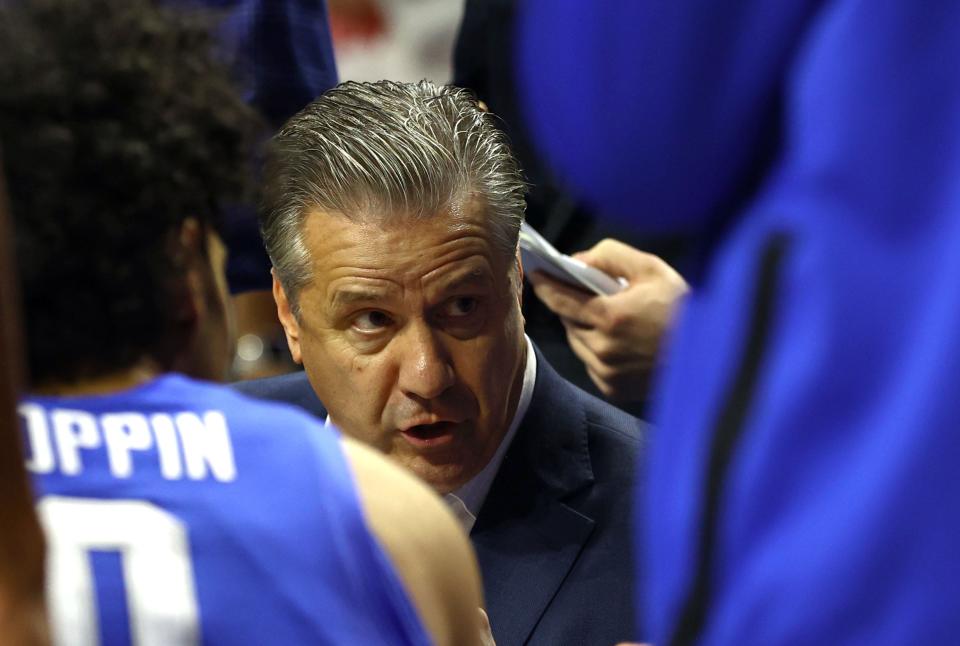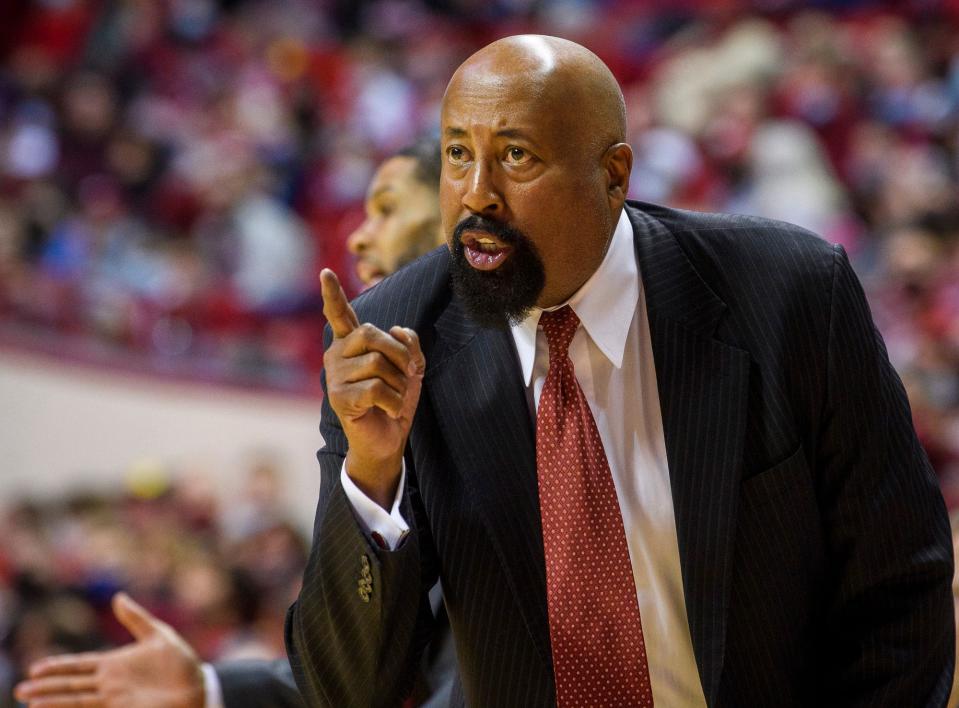First football, now men's basketball: SEC's big spending is changing the landscape of college hoops
Last season's march through the men's NCAA Tournament put Arkansas back on the map with a series of not-since-when achievements: the program's first time in the second round since 2017, first time in the second weekend since 1996 and first time in the Elite Eight since advancing to the national championship game in 1995.
Two interrelated factors threatened to overshadow Arkansas' postseason run.
For one, the surge under second-year coach Eric Musselman coincided with high-profile job searches at programs such as Indiana and Texas. Second, the Razorbacks' deep tournament push came with Musselman tied for 11th in pay, not including reductions taken due to the pandemic, among the 13 SEC head coaches at public universities.
With the Razorbacks on the rise and Musselman's name raised in connection with multiple Power Five openings, updating this contract became a heightened priority for an athletics department with immense expectations around men's basketball: "It’s a sport that we feel like we can win a national championship in," athletics director Hunter Yurachek told USA TODAY Sports.
"At the end of last season, Eric was paid in the lower third of the conference. We felt like he deserved to be paid closer to the upper third of the conference," Yurachek said. "We felt like an investment in Eric Musselman would pay dividends tenfold and felt very comfortable with where we were financially."

The Razorbacks' financial commitment to men's basketball is mirrored across the SEC, where a steady stream of revenue for member schools has pushed coaching salaries to the top of the Power Five. Twelve SEC public-school coaches are making at least $3 million during the 2021-22 year, the most of any conference. In comparison, a combined 14 coaches will earn at least $3 million in the ACC, Big 12 and Pac-12.
And based on industry estimates that project revenue per member school to exceed $100 million annually before the end of the decade, the SEC could soon enter a different stratosphere when it comes to spending on coaching. This ability to make larger and longer financial investments to secure some of the best coaches in the sport has the potential to leave multiple Power Five leagues in the dust and shake up the power structure in men's basketball.
USA TODAY Sports compiled pay information for 78 of the 83 coaches whose schools are either in the Power Five or have appeared in at least three of the past five NCAA Tournaments.

Kansas' Bill Self first to $10M, more women hitting $1M mark as basketball coaches' salaries skyrocket
As these contracts reveal, the SEC has poured more money into men's basketball coaches contracts and seen tangible results — after sending just three teams to the men's tournament as recently as 2016, the conference has four teams in this week's Ferris Mowers Coaches Poll and five teams in USA TODAY Sports' latest bracketology update.
"You’ve got the ability across the spectrum to support success and expect success," Commissioner Greg Sankey said. "The ability to support success is resource-driven, it’s people-driven and it’s infrastructure-driven."
John Calipari, Rick Barnes head of the class
The SEC accounts for five of the 13 highest-paid coaches in the sport, including two of the top six in terms of recurring annual compensation in Kentucky's John Calipari and Tennessee's Rick Barnes.
This represents a notable increase from last season. Including reduction amounts related to the coronavirus pandemic, the SEC had four coaches among the top 10 nationally during the 2020-21 season, but the next highest-paid ranked 22nd and the next after that ranked 27th.

►Calipari ranks first in the SEC and second nationally with total compensation of $8.6 million for this season. He trails Kansas coach Bill Self, who is making $10.2 million in 2021-22 as a result of a $4.5 lump-sum retention bonus.
►In seventh nationally at $5.2 million, Barnes received a two-year contract extension last June. The existing deal included a $250,000 built-in annual increase. Beginning in 2024, Barnes will get a $100,000 annual increase in the years added by the extension. Also, Barnes can earn the highest compensation in bonuses among public school coaches at $3 million. Among them: $400,000 for winning or sharing the SEC regular-season championship; $200,000 for winning the SEC Tournament; and anywhere from $200,000 to $1.5 million depending on the Volunteers' performance in the NCAA Tournament.
►Texas A&M coach Buzz Williams is tied with Musselman for 11th nationally in compensation at $4 million. As part of a deal agreed to in April 2019, Williams' contract includes an annual $100,000 increase.
►Musselman's original deal, signed in 2019, was scheduled to pay at least $2.5 million annually through 2024, with raises available based on the team's NCAA Tournament play. Finalized last April, the reworked contract is worth $4 million annually and runs through the 2026 season, with automatic one-year extensions for 2027 and 2028 based on NCAA Tournament appearances. The contract also includes a $100,000 pay increase each time the Razorbacks reach the NCAA Tournament. Musselman would receive a one-time payment of $1.5 million if he completes the existing contract term, which runs until April 30, 2026.
►Auburn coach Bruce Pearl will make $3.8 million in 2021-22, good for 13th in the country, but will rise up the list of college basketball's highest-paid coaches after signing an eight-year deal set to go into effect May 1. Announced in late January, the contract will bump Pearl's pay to $5.4 million annually with a $250,000 annual increase.
►LSU's Will Wade ranks 19th nationally at $3.5 million, including a one-time retention payout of $1 million if he is the head coach through June 30, 2022.
►After leading Alabama to the SEC regular-season and tournament championship in 2020-21, coach Nate Oats received a three-year extension that increased his base pay to just over $3.2 million, good for 27th nationally. He had been making a little less than $2.5 million annually under a previous five-year deal reached in March 2019.
TOP FIVE UNDERPAID: Leonard Hamilton heads the list
FIRST TO $10M: How Bill Self became first coach to reach eight-figure salary in one year
Treating basketball like football
The 12 SEC coaches making at least $3 million in 2021-22 dwarfs similar totals from all but one of the remaining Power Five leagues. There are only three coaches in the Pac-12 making at least $3 million, led by Oregon's Dana Altman at $3.8 million, good for 14th nationally. Five coaches in the ACC and six in the Big 12 cross the $3 million mark.
Ten make at least that amount in the Big Ten, but only one, Michigan State's Tom Izzo, ranks among college basketball's 19 highest-paid coaches. Izzo will earn more than $8.3 million in 2021-22, including a one-time longevity payment of $4 million if he remains the head coach through April 30, 2022. That puts Izzo third nationally.
This gap in financial commitment shows how the SEC has dealt with hiring and firing in men's basketball with the same approach the conference has long used in football: by being unafraid to outspend every other major conference to hire and retain some of the biggest names in the sport.
As in football, an investment in men's basketball helps move the needle for athletics departments as a whole, allowing SEC member schools to further fund these revenue-driving sports and underwrite non-mainstream men's and women's teams.
"It’s the right place to put your money to see that compounding positive benefit applied to the finances of the department and other sports," said AJ Maestas, the founder and CEO of Navigate, a data-driven consulting firm in sports and entertainment. "You can’t fund these Olympic sports if you don’t have a thriving football and basketball program."
The SEC accounted for five of the eight highest-paid coaches in the Football Bowl Subdivision during the 2021 season, according to research compiled by USA TODAY Sports. If not the leading factor behind the league's success in football — proximity to the nation's most fertile talent bed arguably plays a bigger role — a commitment to investing in coaches, facilities and recruiting budgets has helped the SEC stand alone among FBS conferences for nearly two decades.

While the SEC has not approached that level of dominance in basketball, the conference has made significant strides since the spring of 2016, when Sankey, then completing his first year as commissioner, engaged with university administrators to discuss ways to increase the league's national footprint.
"We had some pretty candid conversations," said Sankey. "We really spent a lot of time trying to figure out how we, the SEC office, can provide a foundation for success."
After putting just three in the field in 2016, the conference has placed at least five teams in each of the last four men's tournaments. At least one SEC team has reached the Elite Eight in three of the those four tournaments; two teams, South Carolina in 2017 and Auburn in 2019, have advanced to the Final Four.
"We have to invest in both our football and men’s basketball programs, because they generate about 90% of the revenue that feeds the rest of our department," said Yurachek. "I can only speak to the University of Arkansas, but yes, absolutely. We are approaching football and men’s basketball, and for us baseball, the same way."
Future of coaching salaries
The projected future revenue streams for the SEC and Big Ten could trigger further investment in men's basketball and alter the landscape of college coaching, according to estimates provided to USA TODAY Sports.
Research conducted by Navigate shows the two conferences surging well ahead of the rest of the Power Five in annual revenue through the end of this decade, boosted by upcoming Tier I, II and III media-rights deals for each conference.
These estimates are based on historical growth rates in media-rights contracts. The findings also include current conference realignment plans, led by the SEC's addition of the Texas Longhorns and Oklahoma Sooners, and factor in College Football Playoff expansion to an eight-team field for the 2026 season.
According to Navigate, annual revenue per school in the Big Ten will jump to $73 million in 2024, when the league will enter into new TV rights contracts, and then steadily increase across the next five years: to $75.2 million in 2025, $86.5 million in 2026, $89.1 million in 2027, $91.8 million in 2028 and $94.5 million in 2029.

The SEC is scheduled to catch up with the Big Ten in 2025, when member shools are projected to earn $74.9 million, and then climb toward annual nine-figure payouts: Navigate projects per-school revenue to reach $96.4 million in 2026, $99.3 million in 2027, $102.3 million in 2028 and $105.3 million in 2029.
Beginning in the 2025 fiscal year, the projected payouts for Big Ten and SEC universities would place these two leagues in a separate class. As determined by Navigate, revenue in the Big Ten and SEC will roughly double that of the remaining Power Five leagues as soon as 2026, when Pac-12 schools are projected to earn $51.7 million, Big 12 schools $47.5 million and ACC schools $43.5 million.
This immense gap has the potential to separate the Big Ten and SEC from the rest of the Power Five and leave the remaining leagues scrambling to keep pace from a spending perspective.
The steady stream of revenue may also precipitate bidding wars over the best coaches in the sport. With money to burn, the two leagues could drive salaries higher and higher through the end of the decade.
"Not only is it not a coincidence," Maestas said, "I think you’ll see many, many more of these coaching deals in the next three or four years."
Follow colleges reporters Paul Myerberg on Twitter @PaulMyerberg and Steve Berkowitz @ByBerkowitz
This article originally appeared on USA TODAY: How much SEC pays men's basketball coaches may alter sport's landscape

